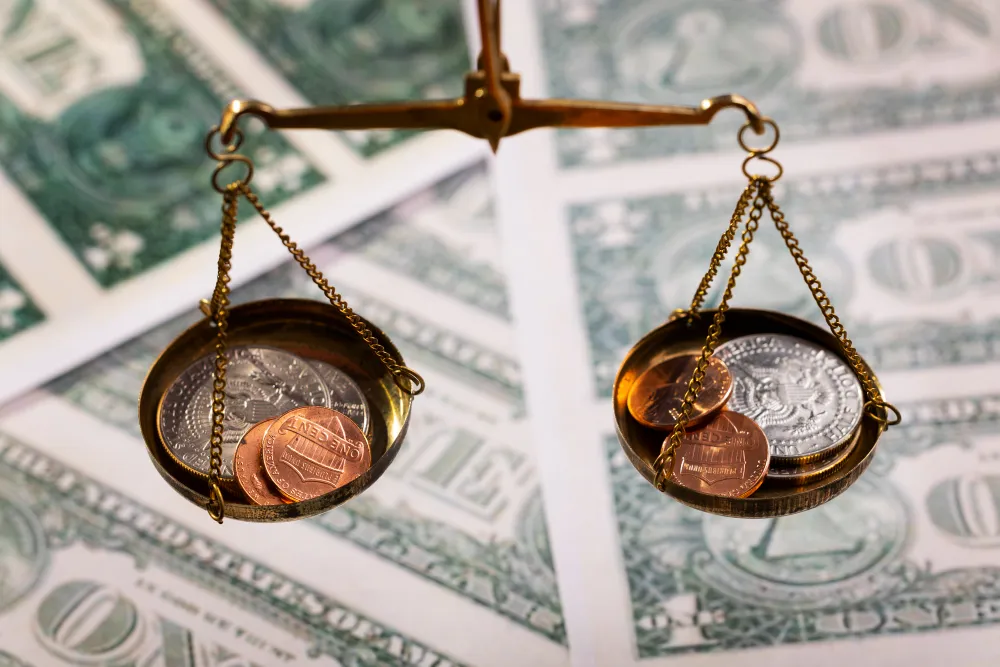Smart Investment Moves During Stagflation
In times of stagnation, it’s essential to take back control and seek good options so your financial life doesn’t come to a standstill.
Investment Tips During Periods of Financial Stagnation
The U.S. economic landscape at certain times challenges even the most experienced investors.
The combination of high inflation with low economic growth creates a complex environment for making investment decisions.

Let’s analyze the characteristics of this scenario, understand its impacts, and explore strategic investment options to navigate it more safely.
Understanding stagflation
Stagflation is the combination of persistent inflation and weak or zero economic growth. This means that while prices are rising, economic activity is not keeping pace.
Unlike “normal” inflation, which often comes with economic growth, stagflation is more concerning because:
- Unemployment tends to rise due to the slowdown in the economy.
- Wages fail to keep up with inflation, reducing purchasing power.
- Risk assets suffer from uncertainty and low market confidence.
Historically, the 1970s in the U.S. were marked by a classic example of stagflation, and the period required strategic changes in monetary and fiscal policy to be overcome.
The Challenges for Investors
Investing during times of stagflation is complicated for two main reasons:
- Fixed income loses appeal: low-yield bonds do not compensate for the loss of purchasing power caused by inflation.
- Equities face volatility: companies suffer from higher production costs and weaker demand, which can reduce profits and impact stocks.
The keyword is protection, seeking assets that preserve real value and may even benefit from inflationary conditions.
Investment Strategies in a High-Inflation, Low-Growth Scenario
Inflation-Protected Securities (TIPS)
The Treasury Inflation-Protected Security (TIPS) is one of the most recommended instruments for protecting capital from inflation.
Unlike traditional bonds, its principal is adjusted according to the Consumer Price Index (CPI), ensuring that real returns are preserved.
Commodities
Historically, commodities such as gold, silver, oil, and agricultural products tend to appreciate during inflationary periods.
Gold is seen as a safe store of value, especially in uncertain times. Oil and energy assets can benefit when inflation is driven by rising energy costs.
Real Estate Investment Trusts (REITs) and Physical Real Estate
The real estate sector can be a good refuge, especially in areas with stable demand, such as large urban centers. Rental income tends to be adjusted for inflation, protecting investor returns.
Defensive stocks
Companies in sectors less sensitive to economic cycles tend to maintain steady demand even during crises, as people need their products or services. Examples include:
- Healthcare: hospitals, pharmaceutical companies, and health insurers.
- Consumer staples: food, hygiene, and cleaning products.
- Utilities: electricity and water services.
International Investments
Diversifying outside the U.S. can reduce risks, especially if other countries are in different economic phases. ETFs in emerging or developed markets can offer protection and new opportunities.
The Role of Cash and Liquidity
Keeping part of your portfolio in cash or highly liquid assets is an important defensive strategy.
In volatile scenarios, the ability to react quickly and seize opportunities can make a difference.
However, it’s essential to balance this position, as idle cash loses value with inflation.
Risks to Avoid
- Long-term debt with low fixed interest rates loses real value over time.
- Cyclical sectors like automotive and tourism also tend to suffer more.
- Highly leveraged investments: higher credit costs impact profitability.
Mindset Adjustments
Facing stagflation requires more than just portfolio adjustments — it requires a shift in how you think about investing.
Be patient, as quick returns are harder to achieve in this environment. Seek quality, prioritizing solid assets with a history of resilience.
Review your risk tolerance — volatility will be higher, and capital preservation should be a priority.
Economic Outlook and Signs of Change
The U.S. economy is dynamic and can emerge from stagflation with appropriate measures, such as tighter monetary policy to control inflation.
Fiscal reforms to stimulate growth and strategic investments in infrastructure and technology are also necessary.
Monitoring indicators like unemployment rate, quarterly GDP, core inflation, and consumer confidence indexes can help anticipate shifts in the economic cycle.
When inflation is high and economic growth is low, investing requires caution, strategy, and discipline.
The key is to understand that, in stagflation scenarios, the main goal is not just to grow — but to preserve and, when possible, safely increase your wealth.






